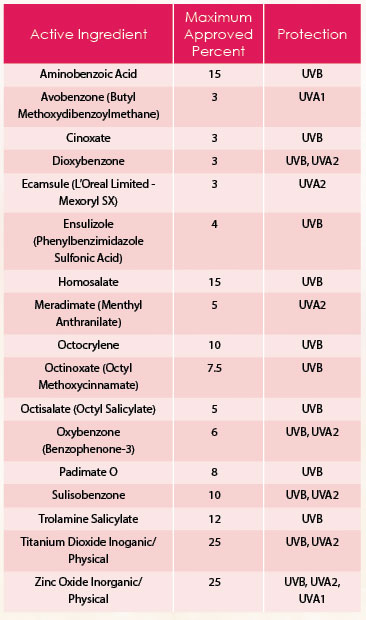As the trend of cross-category sun protection continues, sunscreens are now becoming synonymous with anti-aging.
People who use sunscreen daily show 24 percent less skin aging than those who do not use sunscreen daily. Even though we accumulate approximately 73 percent of our lifetime ultraviolet exposure by age 55, daily sunscreen use by adults age 55 and under can still reduce skin aging.¹
In the United States, sunscreens are over-the-counter drugs regulated by the Food and Drug Administration (FDA). In 2011, the FDA added broad-spectrum, 40- and 80-minute water resistance claims and maximum SPF value to United States standards, along with updating other labeling clarifications. Though the FDA languishes behind most other countries, it created a “time and extent application” (TEA) process in January 2002 to help address the route of approval for over-the-counter drugs. Unfortunately, many extent application sunscreen ingredients are still on hold, despite years of safe use in other countries. Throughout 2013 and 2014, the Public Access to SunScreens (PASS) Coalition was created and assisted in the draft of the Sunscreen Innovation Act. September 2014 brought passage of the Sunscreen Innovation Act (S.2141) and it is off to the President for hopeful signature and enactment to law. The act requires that new sunscreen applications be reviewed within 11 months and that the current backlog for sunscreen active ingredient applications must be reviewed within eight months. Unrelated to the time and extent application program, the proposed act also requires that FDA issue determinations regarding testing and labeling of sunscreen sprays and sunscreen drug products with an SPF above 50.
 Working with What we Have
Working with What we Have
Research and development in the United States has evolved differently to maximize the sunscreen ingredients allowed and how to exploit their potential within formulations.
The United States currently has 17 sunscreen ingredients permitted, primarily organic/chemical filters. Typically, only 10 common active ingredients are used for various reasons and combinations of two to six of these common sunscreen active ingredients are used in products to achieve the desired SPF value. There are various restrictions on the maximum percentage and certain combinations of the active ingredients are not allowed. Mineral sunscreens comprise use of titanium dioxide and zinc oxide; zinc oxide is currently the only mineral sunscreen allowed with certain combinations of other sunscreen actives.
One challenge of the current United States sunscreen ingredients is the limitation of UVA filters available to provide broad-spectrum protection. Broad-spectrum avobenzone provides UVA1 and some UVA2 protection and is notoriously photo-unstable and requires stabilizing with added quenching ingredients to remain efficacious in sunscreen formulations. Avobenzone is used with combinations of UVB filters and had, until the end of 2013, patent protected limitations of two percent that increased the difficulty to photostabilize it. One ingredient that has proven useful is Hallstar®’s ethylhexyl methoxycrylene; it is highly efficient in photostabilizing avobenzone and octinoxate, while outperforming octocrylene as an avobenzone photostabilizer. Other patented stabilizer technologies continue to emerge along with many ingredients to increase formula stability, enhance film-forming properties on the skin for even distribution, and/or boost SPF values. Other ingredients offer UVA-boosting technology such as croda’s tris (PPG-3 benzyl ether) citrate in the presence of avobenzone or oxybenzone. It functions by shifting the critical wavelength of the formula into the UVA spectrum. By boosting sunscreen actives that may be at their maximum limit or working around some sunscreen actives, preserving the broad-spectrum properties are key to product effectiveness. Kobo products ingredient integrates a cocktail of stable antioxidants that not only maximizes ultraviolet protection in organic and inorganic sunscreen formulations by 30 percent or more, but the same level of UVA-boosting was observed while delivering all the benefits of the antioxidants. Antioxidant activity can elevate the benefits of the formulation towards global photo protection; maintaining the activity of antioxidants has proved to be very challenging in sunscreen formulations.
Zinc oxide is a globally-approved sunscreen active that provides broad-spectrum protection and has a multitude of varying particle sizes and surface treatments, allowing formulators to find the right balance between transparency and increased sensory appeal. Polymer-coated, dispersions, and reduced particle sizes of zinc oxide mitigate whitening, increase stability for optimal SPF/broad-spectrum results, and lend superior aesthetics. Titanium oxide suppliers offer numerous versions that comply with the 2014 scientific committee for consumer safety conclusions. Distinct features of multiple coatings can yield increased sensory benefits and other ingredients demonstrate that broad-spectrum protection can be attained with titanium dioxide as a stand-alone active ingredient. If United States regulations of active ingredient combinations are amended, titanium dioxide can achieve extremely photostable, safe, high SPF, and broad-spectrum formulations with current and pending sunscreen active ingredients.
 Sunscreen Ingredients Awaiting FDA Review
Sunscreen Ingredients Awaiting FDA Review
Many sunscreen applications have been pending in the FDA’s queue, some since 2002. As we become a more global community seeking harmonization, there is a need for integration of international sunscreen ingredients. Many personal care companies and raw material suppliers have global distribution and the benefits of the pending sunscreen applications are realized and known. Two of the pending sunscreen ingredient applications are proprietary to L’Oréal, although L’Oréal’s ecamsule is currently approved for formula-specific products in the United States. Additionally, at the end of February 2014, the FDA published two letters on the time and extent applications for iscotrizinol/diethylhexyl butamido triazone (uvasorb HEB) and amiloxate (neo heliopan E 1000), finding insufficient scientific evidence to claim either as generally recognized as safe and effective and denying their addition to the over-the-counter sunscreen monograph. The FDA will continue to accept additional data and public input regarding the two-time and extent applications. Enzacamene has been receiving some minor negative press in other countries where it is approved, and it will be of interest to see the FDA’s final decision regarding its approval. In general, most of the pending sunscreen applications would provide a wider array of beneficial sunscreen actives. The UVA actives, bemotrizinol and bisoctrizole, are of particular interest to formulators for longer and better ultraviolet A protection. The advantages to formulating with the pending UVA actives allow photostabilized formulations with improved aesthetics and will provide a larger breadth of broad-spectrum sunscreens products available in the United States.
One of the pending time and extent applications being utilized in other countries is BASF’s ethylhexyl triazone. It provides extremely strong absorbance in the UVB spectrum for highly-effective protection from sunburn. While offering proven synergies with other ultraviolet active ingredients, lower amounts of sunscreen actives can be used in the final formulation.
Another, Ashland’s hydroxyPhenyl triazine, is an ultraviolet filter ingredient that protects against both UVA and UVB, providing broad-spectrum protection in a single ingredient. In particular, it provides photostable, effective, and long-lasting protection against UVA radiation and can synergistically boost the performance and formula stability with combinations of other sunscreen active ingredients.
Even though the United States has emerged successful in adapting technology with the currently approved sunscreen active ingredients, its sun care category will benefit greatly from the approval of the pending-time and extent-application sunscreen ingredients, especially the UVA ingredients. Until then, developments in photochemistry, United States trends of mineral sunscreens, and the constant survey of functional botanicals and bioavailable antioxidants will continue. Along with photosensitivity studies and research contribution of biological relevance of global solar spectrum, photoaging mechanisms will keep the United States as safe and innovative as possible until regulatory guidelines are clarified.
References:
¹Hughes MCB, Williams GM, et al., (2013). Sunscreen and prevention of skin aging: a randomized trial, Ann Intern Med, 158(11):781-90.
Svobodova, A. and Vostalova, J., (2010). Solar radiation induced skin damage: review of protective and preventive options, Int. J. Radiat. Biol. 86: 999-1030.
Society for Melanoma Research 2013 Congress, (2013). Pigment Cell and Melanoma Research 26.6, 835-44.
Levell, N.J., Beattie, C.C., Shuster, S., et al., (2009). Melanoma epidemic: a midsummer night’s dream? British Journal of Dermatology, 161: 630-34.
Lott, D., (2013). Testing SPF 15-100, Indoor vs. Outdoor.
Grabenhofer, Rachel L., (2014). Sunscreen Innovation Act Passes: What Does It Mean? Cosmetics and Toiletries.
 Diahne Patnode, expert cosmetic chemist, has over 25 years of progressive experience in formulating and developing trendsetting cosmetic products for some of the most recognized names in the industry, including Redken Laboratories, philosophy/BioMedic, and Arbonne International. After studying biochemistry at the University of Arizona, she discovered the beauty industry and an insatiable curiosity for discovering the latest technological advances to create cutting-edge prestige products. As a leader in Research and Product Development, she continues to provide insight that delivers market leading products. Patnode holds multiple patents and is an active member of the Society of Cosmetic Chemists and Beauty Industry West.
Diahne Patnode, expert cosmetic chemist, has over 25 years of progressive experience in formulating and developing trendsetting cosmetic products for some of the most recognized names in the industry, including Redken Laboratories, philosophy/BioMedic, and Arbonne International. After studying biochemistry at the University of Arizona, she discovered the beauty industry and an insatiable curiosity for discovering the latest technological advances to create cutting-edge prestige products. As a leader in Research and Product Development, she continues to provide insight that delivers market leading products. Patnode holds multiple patents and is an active member of the Society of Cosmetic Chemists and Beauty Industry West.
Want to read more?
Subscribe to one of our monthly plans to continue reading this article.